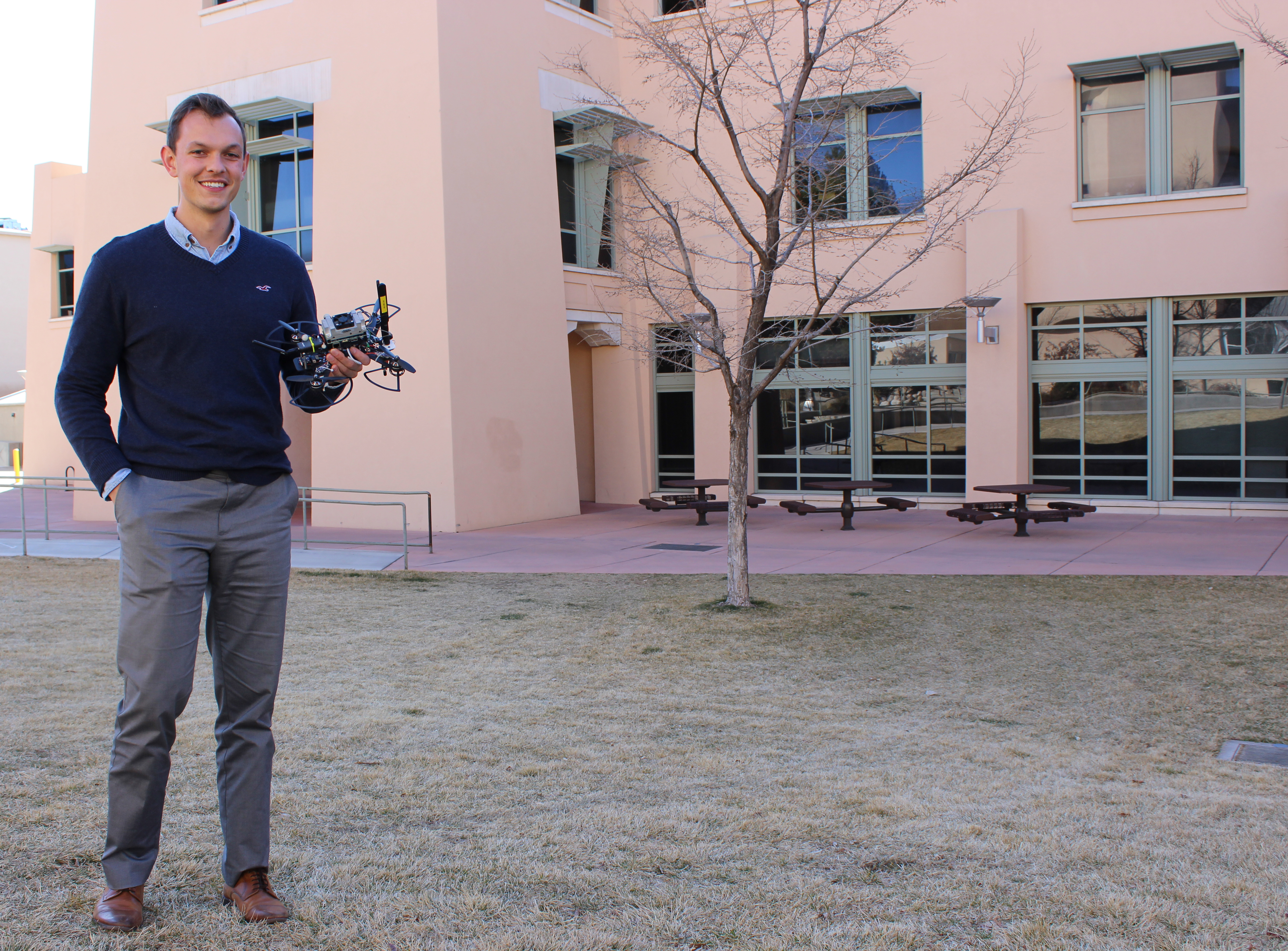Recent News
UNM joins Brown University in national institute focused on intuitive, trustworthy AI assistants
August 6, 2025
UNM Engineering team wins ASEE best paper for work on first-year engineering course
July 17, 2025
New director will enhance interdisciplinary engineering learning opportunities
July 2, 2025
Final SIRI cohort visits UNM campus
June 30, 2025
News Archives
UNM, Sandia collaborate on project to assess threats of small unmanned aerial systems
February 25, 2020 - by Kim Delker

Mechanical Engineering graduate student Isaac Seslar works on MARCUS
Small unmanned aircraft — what are known widely as drones — have drastically increased in popularity in the last several years. No longer restricted to electronics buffs, they are now flown by hobbyists, used by photographers to take aerial photos, and even are in use by commercial entities to deliver packages to your door.

But with their growth in popularity has come concerns about the safety of these small aircraft. Although those who fly them are technically restricted to certain heights to avoid interference with aircraft, it is hard to police these devices and to tell if unmanned aircraft are a threat to national security.
That is the focus of a new project involving researchers from around the globe. A group from The University of New Mexico is working with Sandia National Laboratories robotics experts on efficient ways to intercept enemy unmanned aircraft systems midflight.
Rafael Fierro, a professor in the Department of Electrical and Computer Engineering at UNM, is leading the UNM part of the project. He directs the Multi-Agent, Robotics, and Heterogeneous Systems (MARHES) Laboratory at UNM, which has extensive experience in real-time control of unmanned aerial systems, including working with Sandia on the precursor to this project.
The Sandia group previously successfully tested their concept indoors with a swarm of four unmanned aircraft systems that flew in unison, each carrying one corner of a net. Acting as a team, they intercepted the flying target, trapped it in air like an insect caught in a web, and safely lowered it to the ground.
This test has been part of a two-year Laboratory Directed Research and Development project called Aerial Suppression of Airborne Platforms (ASAP). That demonstration led to funding for three years of continued research and testing for the Mobile Adaptive/Reactive Counter Unmanned System (MARCUS) project, which will address current and future national security threats posed by small unmanned aircraft systems.
Fierro and a group of three UNM graduate students are working on four main tasks for MARCUS:
1). Developing a test bed for small unmanned aerial systems (sUAS) detection. This involves the creation of software needed to control and navigate multiple UAS devices on a test bed. They will also use machine learning algorithms for sensor fusion and sUAS identification.
2). Tracking and assessment to provide efficient, collision-free paths to target intercept goals while accounting for dynamic sUAS threat behavior. Through the use of algorithms for tracking and assessment, the group is setting out to identify efficient collision-free paths to target intercept goals while taking into account dynamic sUAS threat behavior.
3). Applying neutralization techniques to minimize collateral damage according to the environmental conditions. In this task, the team will investigate and evaluate different neutralization approaches through modeling and simulation activities.
4). Testing and evaluation by conducting experiments to evaluate the impact of online motion planning on the probability of intercept. The team will report the data from the results of a series of multi-UAV experiments that will statistically evaluate the impact of using the proposed motion-planning algorithms.
“The overall goals of what we are working on with MARCUS are detection and identification; tracking and assessment; and neutralization of the threat of unmanned aerial vehicles,” Fierro said. “The UNM team will be providing its expertise in UAV swarm coordination and vision-based navigation to address the challenge presented in the MARCUS project.”
The MARCUS project is funded by the NATO Science for Peace and Security Programme, and incorporates advanced algorithms funded by the Department of Homeland Security Science and Technology Directorate. The work is being performed in partnership with armasuisse Science and Technology of the Swiss Federal Department of Defence, Civil Protection and Sport.
UNM’s share of the grant is about $300,000. The estimated end date of the project is May 2022.
